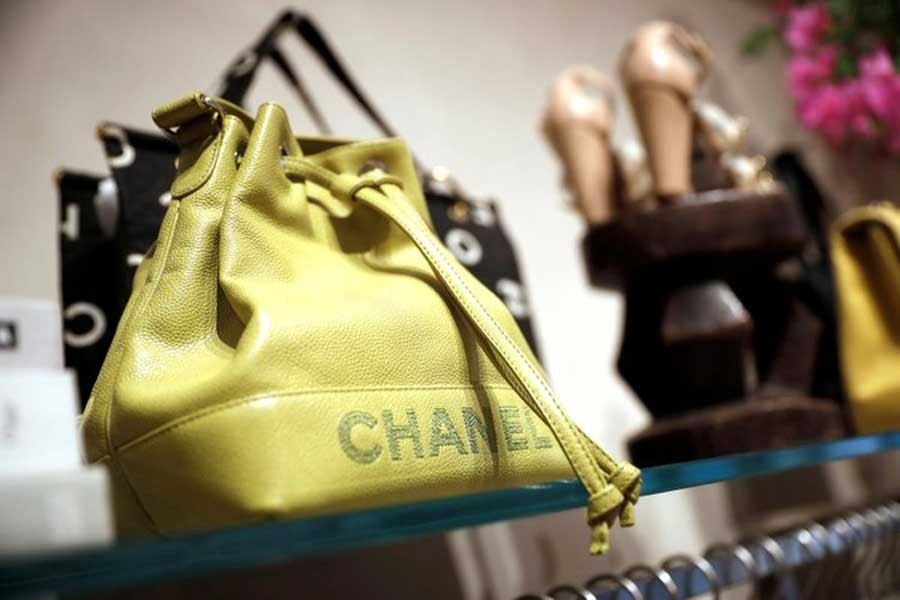An escalating trade war between the United States and China could abruptly end a glittering stock market run for luxury goods firms, with some investors already put off by lofty valuations in a sector powered by shoppers in the two countries.
From pricey handbags to designer shoes, booming sales at the European companies that dominate the industry like Louis Vuitton owner LVMH and Gucci parent Kering have made them investor favourites, with shares still near record highs.
But the possible trickle down effect of tit-for-tat tariffs hikes on consumers is adding to jitters over heady valuations, even though luxury firms are not as directly threatened by rising protectionism as carmakers and industrial companies.
The sector has an average valuation of 21 times 12-month earnings forecasts, according to Reuters data, down from its May peak, but still 23 per cent above its 10-year average.
“We are not making a call that they are bad companies, we think they’re great companies. But they’re bad investments,” said Edinburgh-based David Keir, co-manager of the Saracen Global Income and Growth fund, which dropped its LVMH holdings last year and sold out of German suit maker Hugo Boss in early July. “Now there’s an incremental risk from the great unknown of trade tariffs as well.”
It would not be the first demand-driven wobble the luxury industry has faced. In 2012, a Chinese crackdown on corruption caused purchases of premium cognac and other high-end goods used as gifts to fall sharply, taking the likes of LVMH and Remy Cointreau shares down with them.
This time, tariffs threaten consumers’ spending power in both the United States and China – the world’s two biggest consumers of European luxury goods, which make up just over half the industry’s revenues.
The impact on confidence in China’s markets, including the depreciation of the renminbi that would eat into Chinese tourists’ budgets for shopping in Europe, is among risks that may not be fully reflected in stocks yet, analysts warn.
“We see very little priced in so far,” said UBS analysts, who forecast as much as a 30 per cent share price drop in the sector index in the event of a fully-fledged trade war.
Among the stocks that would be worse affected, UBS included Italy’s Salvatore Ferragamo and Britain’s Burberry. The two brands are in the midst of turnaround plans that have yet to fully hit their stride.
China thriving
So far, the knock-on effect on revenues has been muted.
If anything, Chinese demand for Louis Vuitton’s leather goods ticked up in the second quarter compared to the first, LVMH reported, while most firms argue their core clientele is here to stay.
“We have still an expansion of the middle and upper class in China,” Kering’s group managing director Jean-Francois Palus told analysts following the company’s half-year results.
Sales in China have been largely driven by a young clientele unafraid of splurging on branded goods, and often financed by their parents and grandparents, with rising property prices also providing a source of wealth.
Even a moderate slowdown in the pace of revenue growth, as is expected regardless of the trade spat after two years of rebounding demand in China, is not enough to spook some drawn to the sector’s underlying strengths.
“Demand is really healthy,” said Andrea Gerst, co-portfolio manager of GAM’s Luxury brands fund, which has stakes in many major European labels. “If comparatives get more difficult, then the absolute madness may not be as strong, but there’ll still be healthy growth.”
More broadly, global luxury sales are driven by some of the world’s wealthiest shoppers who might shrug off any direct impact from tariffs were it to come to that.
“With luxury you’ve got people who are far less price-sensitive as your customers and so you ask yourself if there’s a tax put on and the price goes up a bit, how much is that really going to change the demand?” said Fergus Shaw, partner and portfolio manager at Cerno Capital.
Shaw said his fund owns LVMH shares, and he has not been tempted to sell out, expecting any impact from tariffs to be much smaller than the anti-corruption drive was.
Nerves
Yet market nerves around the sector are becoming more evident, and luxury companies and industry lobbies are on alert. Even good or in-line results from luxury companies for the second quarter prompted some sharp sell-offs on results day.
Analysts at Kepler Cheuvreux downgraded the luxury sector at the start of July to “underweight”, citing trade war worries.
Italy’s Confindustria Moda, the national association of textile and fashion companies, said its entrepreneurs feared a possible rise in tariffs and that it was monitoring the situation in the hope of avoiding “a protectionist escalation”.
It estimates goods in the sector are already subject on average to 12 per cent trade tariffs, and are unlikely to be targeted for increases, however.
Though the bulk of luxury manufacturing is still anchored in Europe, some firms are also weighing whether to make changes to their supply chains should they get caught in the crossfire, Reuters reported.
“This is an industry in which we have the capability, as we do and as we have done in the past, to switch capacity from one location to the other as is necessary,” Ray-Ban maker Luxottica’s (LUX.MI) finance chief Stefano Grassi told analysts following second-quarter results.
The Italian group, which makes designer sunglasses for Chanel and Versace among other labels, could for example shift more production to the United States if needed, where it has a factory. It also has three in China, while the majority of its plants are in its home base.


